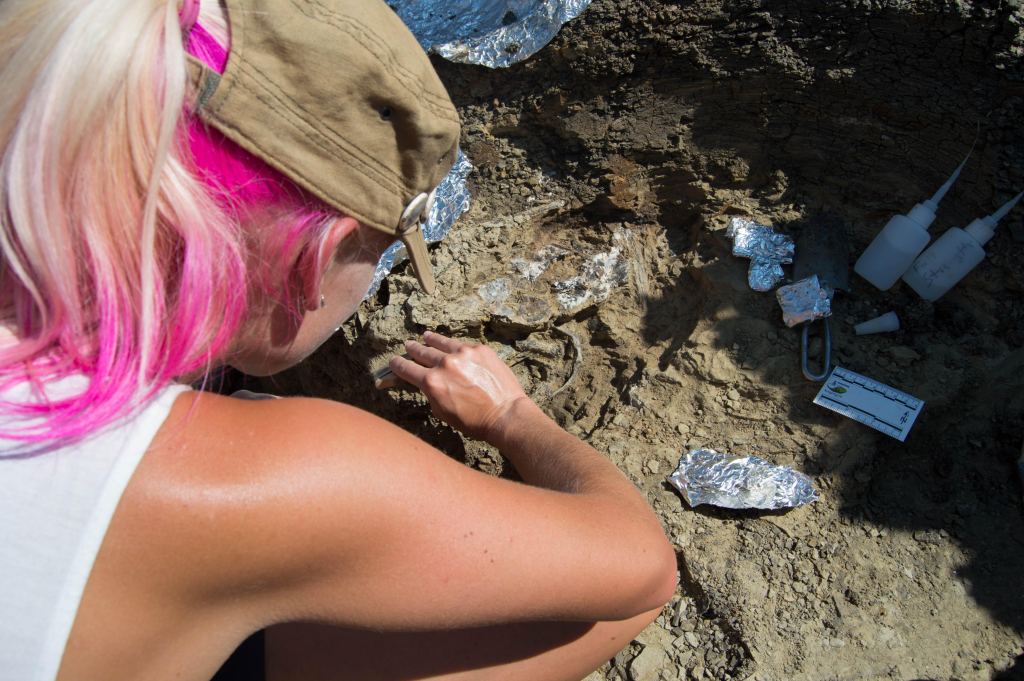We don’t Know Exactly When the Dinosaurs Died, but Now We Know it was in the Springtime
By Nancy Atkinson
We’ve long known a disaster took place about 66 million years ago, where in a geological instant, 75% of the plants and animals on Earth were wiped out, including all the land-roaming dinosaurs. But here’s a new detail about that event: Even though we can’t pinpoint exactly what year this disaster took place, we now know it happened during the springtime.
Most scientists agree the disaster was an asteroid impact, where an asteroid at least 10 kilometers wide struck the Chicxulub region in the present-day Yucatán Peninsula in Mexico. The impact released 2 million times more energy than the most powerful nuclear bomb ever detonated.
While previous studies looking at the timing of this event have focused on millennial timescales, a new study from Melanie During and colleagues from the University of Sweden focused on pinpointing seasonal information of fossilized fish found in a site in North Dakota, that perished as a result of the devastating impact.
The devastation created layer of ash sandwiched between layers of rock, known as the Cretaceous-Paleogene (K–Pg) boundary, formerly known as the Cretaceous–Tertiary (K-T) boundary, which is found across the world in the geologic record. It includes a layer of iridium, an element common in asteroids but rare on Earth. It was this ‘iridium anomaly’ that first revealed the extinction event as an asteroid strike to geologists more than three decades ago.

Well-preserved fossil bones of filter-feeding sturgeons and paddlefishes found in the Tanis fossil site in North Dakota had impact debris lodged in their gills, but nowhere further down the digestive system, suggesting an almost-instantaneous death occurred when an impact-triggered seiche –continental water shaken by the impact — caused a sudden upriver surge.
The researchers found distinct growth patterns in the fossils that provided record of seasonal change, of when the fish had reproduced and had developing offspring. In the northern hemisphere, this would have been in the spring.

“We postulate that the timing of the Chicxulub impact in boreal spring and austral autumn was a major influence on selective biotic survival across the Cretaceous–Palaeogene boundary,” the authors wrote in their paper, published in Nature.
The timing of the collision, at least for the Northern Hemisphere, would have come at a particularly sensitive stage in the biological life cycles of many plants and animals.
“I think spring puts a large group of the late Cretaceous biota (animal and plant life) in a very vulnerable spot because they were out and about looking for food, tending to offspring and trying to build up resources after the harsh winter,” Melanie During said at a news briefing.
By contrast, the researchers said that ecosystems in the Southern Hemisphere, where it was fall when the asteroid collided with Earth, appear to have bounced back nearly twice as fast as those in the Northern Hemisphere.

Even though these fossils were found 3,000 kilometers (1,864 miles) away from the impact crater, the details of the dig show the large fish – which are up to a meter (3 feet) long — died dramatically shortly after the asteroid strike. They were buried alive by sediment displaced as a massive body of water unleashed by the asteroid strike moved upstream.
Impact spherules — small bits of molten rock ejected from the crater went high into the atmosphere or even to space where they crystallized into a glass-like material — were found lodged in the fishes’ gills.
“These impact spherules got ejected into space, …and rained back down on Earth,” During said. “This deposit literally looks like a car crash frozen in place. It looks like the most violent thing I have ever seen, preserved in pristine condition.”
This new study coincides with previous studies from as early as 1991 which showed fossils in the same condition, which suggested is happened in June, along with another study from December of 2021, which also concluded the extinction event happened in spring.
Lead image caption: Melanie During excavating a paddlefish in the Tanis deposit. Credit: Jackson Leibach, via Nature.
Additional reading: Nature press info, and paper
The post We don’t Know Exactly When the Dinosaurs Died, but Now We Know it was in the Springtime appeared first on Universe Today.

February 24, 2022 at 01:06AM
via Universe Today read more...

Post a Comment